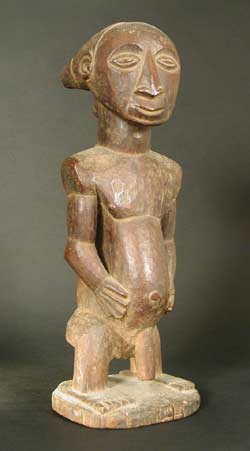African Art / Hemba Wooden Ancestor Sculpture, 20th Century CE
Wood
17.1 x 45.7 cm
6 3/4 x 18 in
6 3/4 x 18 in
PF.3409 (LSO)
This powerful sculpture of a standing male is an ancestor figure from the Hemba group of what was once Zaire. It is a classical representation, standing on a rounded wooden...
This powerful sculpture of a standing male is an ancestor figure from the Hemba group of what was once Zaire. It is a classical representation, standing on a rounded wooden base, with comparatively short, flexed legs, a long torso, a columnar neck, carefully “jointed” arms, a substantial “block-shaped” penis, a protuberant stomach (with hands resting upon it), delineated pectorals and a circular umbilicus. The head is unusual in terms of style and execution. The coiffure is rendered as a quadruple eminence resembling short “posts”, one at each of the cardinal points. The face is more exuberantly carved than is traditional, with large, rather open oval eyes, a long, wide nose and a semi-smile that endows the figure with something of an amused expression. The proportions and care with which small details – such as the fingers – have been carved make this a pleasing, albeit unusual, piece. The surface of the piece is glossy and burnished, implying a long history of handling and the application of libations.
The Hemba are an agriculturally-based group living on the banks of the Lualaba River, in what was once Zaire. They are arranged into large groups which approximate to clans, each of which has a common ancestor, and is headed by an elder known as the Fuma Mwalo. He is responsible for justice, receives tribute from his subordinates; his power is counterbalanced by secret societies called Bukazanzi (for men) and Bukibilo (for women).
The Hemba were long believed to be contiguous with the Luba, and only achieved sociocultural independence in the eyes of western African art history in the 1970s. The Luba and the Hemba are socioculturally and artistically similar in many respects. However, artistic production can be differentiated in terms of the delicacy (enthusiasts would describe it as “refinement”) of the carving. They are known for their decoration of secular and utilitarian objects, notably caryatid stools, headrests and instruments; Masks are highly distinctive – wither monkey masks, or perfectly symmetrical plain masks with slit eyes that are reminiscent of Lega pieces – although their social role is currently unclear. In general terms, figure features tend to be sharper, with more peripheral detailing (such as hair and beards) and a subtle geometric quality. One of the very few indigenous artists known specifically to western art historians was a member of the Hemba group; the “Master of Buli” is known for his unique rendering of human features in an elongated, somewhat simian manner. Hemba figures – singiti – usually represent male ancestors, naked figures standing on circular bases, with elongated torsos, hands resting on the stomach (usually protuberant, perhaps representing wealth or prosperity), beards, and coiffure drawn back and formed into the shape of a cross. Warrior figures (carrying weapons) confer power, and are usually kept by the Fuma Mwalo; they usually have an encrusted patina as animals (usually chickens) are sacrificed to them during ceremonies to recall the glories of their lives. The Fuma Mwalo also keeps small Janus figures known as kabejas, which are made magical by the addition of substances to small depressions in their heads; their role is to protect the village, and also receive libations to ensure they do so adequately.
This is an attractive and refined piece of African art, and is a striking addition to any collection.
The Hemba are an agriculturally-based group living on the banks of the Lualaba River, in what was once Zaire. They are arranged into large groups which approximate to clans, each of which has a common ancestor, and is headed by an elder known as the Fuma Mwalo. He is responsible for justice, receives tribute from his subordinates; his power is counterbalanced by secret societies called Bukazanzi (for men) and Bukibilo (for women).
The Hemba were long believed to be contiguous with the Luba, and only achieved sociocultural independence in the eyes of western African art history in the 1970s. The Luba and the Hemba are socioculturally and artistically similar in many respects. However, artistic production can be differentiated in terms of the delicacy (enthusiasts would describe it as “refinement”) of the carving. They are known for their decoration of secular and utilitarian objects, notably caryatid stools, headrests and instruments; Masks are highly distinctive – wither monkey masks, or perfectly symmetrical plain masks with slit eyes that are reminiscent of Lega pieces – although their social role is currently unclear. In general terms, figure features tend to be sharper, with more peripheral detailing (such as hair and beards) and a subtle geometric quality. One of the very few indigenous artists known specifically to western art historians was a member of the Hemba group; the “Master of Buli” is known for his unique rendering of human features in an elongated, somewhat simian manner. Hemba figures – singiti – usually represent male ancestors, naked figures standing on circular bases, with elongated torsos, hands resting on the stomach (usually protuberant, perhaps representing wealth or prosperity), beards, and coiffure drawn back and formed into the shape of a cross. Warrior figures (carrying weapons) confer power, and are usually kept by the Fuma Mwalo; they usually have an encrusted patina as animals (usually chickens) are sacrificed to them during ceremonies to recall the glories of their lives. The Fuma Mwalo also keeps small Janus figures known as kabejas, which are made magical by the addition of substances to small depressions in their heads; their role is to protect the village, and also receive libations to ensure they do so adequately.
This is an attractive and refined piece of African art, and is a striking addition to any collection.
